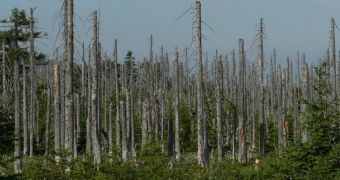Many acids result from the combination of a nonmetal oxide with water.
Water can be found in nature, the oxides can be dumped by human activity, especially the burning of fossil fuels. This is how acid rains result: rains filled with acids.
The main causes are the nitrogen and sulfur oxides, that give nitric and sulfuric acids, the most powerful known acids. There are also some natural sources for acid rains, like volcanic eruptions or fires, but these sources are balanced.
But the human contribution is much more important. Only in 1977, US dumped into the atmosphere 31 million tons of sulfur oxides and 22 million of nitrogen oxides. This means about 500 kg per capita.
80 % sulfur oxides come from the burnings of the energy generating installations, 15 % from various industrial burnings and 5 % from other sources. In the case of the nitrogen oxide, one third comes from the burnings of the energy generating installations, one third from transport fuel burning and the rest from various sources.
The acid rains are extremely harmful for the environment. Sometimes, the snow, too, can be acid, and even blackened. When this snow melts, the water resulted can be ten times more acid than that resulted from acid rains. First acid rains have been detected in the '50s in Norway: the scientists were puzzled by the dwindling number of fish in the Norwegian lakes.
In the neighboring Sweden, 4,000 lakes remained fishless, 9,000 lost great part of their fish, while other 20,000 were touched by the acid rain.
The researchers found that the oxides that caused the acid rains in Scandinavia were expelled by the English heavy industry, especially the high chimneys of the plants of Sheffield and Birmingham but also from the German industry of the Ruhr.
The cyclones carry these oxides till the mountains of Scandinavia where the rains bring them down. Annually 56,000 tones of sulfur oxides fall over Norway, 75 % being "imported".
In UK acid rains fall just like in Scandinavia, and the most acid rain was recorded near Perth (Scotland): 500 times more acid than natural acidity. Acid rains are frequent also in northeastern US and Canada, east of Manitoba (Canada being the victim of the American industry). Due to the very high industrial chimneys (over 300 m or 1,000 ft), the eliminated oxides will kill fish, frogs and water lilies at thousands of km away.
The chimney of the copper and nickel plants of the Canadian city Sudbury, over 400 m (1,330 ft) tall, eliminates 1% of the sulfur content of the atmosphere of our planet. The fish disappear because the acid rains kill their food sources, the plants and their offspring. Without the fish, birds and mammals are gone too.
But the acid rains also kill the forests. They wash away the soil of nutritive compounds and kill its useful microorganisms. The acid rains weaken the defense mechanisms of the tress, left vulnerable to stress: disease, parasites, weathering.
The larches (Larix) are extremely sensitive to acid rains.
Over half of the forests of western Germany are in various degrees of destruction and timber loss due to acid rain is estimated at $ 800 million annually.
In Switzerland, in 1984 only 12 million trees (14 % of the country's forest area) had to be cut, while in Holland, 40 % of the surface is affected by acid rains. But also man-made structures are attacked by the acid rains: cement, concrete, lime, marble, metal, basalt and granite and the damages can be huge.
In London, the acid rains affected severely stone artwork from the XIII-XIXth centuries, like the English Parliament, Westminster Abbey and Saint Paul Cathedral.
Human health too is affected by the acid rains: they increase the vulnerability to respiratory tracts infections, causing and aggravating lung diseases and increasing morbidity amongst those suffering from a lung condition.
In Canada 4,000 persons die annually due to the acid rains induced by the sulfur oxides, half of them in the Ontario province.

 14 DAY TRIAL //
14 DAY TRIAL // 
